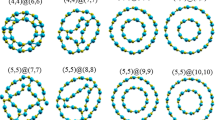Abstract
Armchair carbon nanocoils (CNCs) with different geometric parameters are constructed and optimized using a tight-binding (TB) total energy model. The quantum conductance of these nanocoils is simulated employing a π-orbital TB model incorporated with the non-equilibrium Green’s function theory. Compared with the perfect armchair carbon nanotubes (CNTs) and armchair CNTs with only Stone-Wales (SW) defects, the quantum conductance spectra of the armchair CNCs present distinct gaps around the Fermi level, which are mainly originated from the existence of sp3 carbon in the three-dimensional spiral structures. Moreover, the detailed conductance spectra of the armchair CNCs depend sensitively on their geometric parameters, such as tubular diameter and block-block distance.
Similar content being viewed by others
References
Dunlap B I. Connecting carbon tubules. Phys Rev B, 1992, 46: 1933–1936
Ihara S, Itoh S, Kitakami J-i. Helically coiled cage forms of graphitic carbon. Phys Rev B, 1993, 48: 5643–5647
Amelinckx S, Zhang X B, Bernaerts D, et al. A formation mechanism for catalytically grown helix-shaped graphite nanotubes. Science, 1994, 265: 635–639
Zhang X B, Zhang X F, Bernaerts D, et al. The texture of catalytically grown coil-shaped carbon nanotubules. Europhys Lett, 1994, 27: 141
Akagi K, Tamura R, Tsukada M, et al. Electronic structure of helically coiled cage of graphitic carbon. Phys Rev Lett, 1995, 74: 2307–2310
Akagi K, Tamura R, Tsukada M, et al. Electron and hole g factors measured by spin-flip Raman scattering in CdTe/Cd1−x MgxTe single quantum wells. Phys Rev B, 1996, 53: 2114–2120
Lu W G. Quantum conductance of a helically coiled carbon nanotube. Sci Technol Adv Mater, 2005, 6: 809–814
Hayashida T, Pan L, Nakayama Y. Mechanical and electrical properties of carbon tubule nanocoils. Physica B-Condens Matter, 2002, 323: 352–353
Volodin A, Ahlskog M, Seynaeve E, et al. Imaging the elastic properties of coiled carbon nanotubes with atomic force microscopy. Phys Rev Lett, 2000, 84: 3342–3345
Chen X Q, Zhang S L, Dikin D A, et al. Mechanics of a carbon nanocoil. Nano Lett, 2003, 3: 1299–1304
da Fonseca A F, Malta C P, Galvao D S. Mechanical properties of amorphous nanosprings. Nanotechnology, 2006, 17: 5620–5526
Sanada K, Takada Y, Yamamoto S, et al. Analytical and experimental characterization of stiffness and damping in carbon nanocoil reinforced polymer composites. J Solid Mech Mater Eng, 2008, 2: 1517–1527
Qi X, Zhong W, Deng Y, et al. Synthesis of helical carbon nanotubes, worm-like carbon nanotubes and nanocoils at 450°C and their magnetic properties. Carbon, 2010, 48: 365–376
Tang N, Wen J, Zhang Y, et al. Helical carbon nanotubes: catalytic particle size-dependent growth and magnetic properties. ACS Nano, 2010, 4: 241–250
Ebbesen T W, Lezec H J, Hiura H, et al. Electrical conductivity of individual carbon nanotubes. Nature, 1996, 382: 54–56
Liu L, Gao H, Zhao J, et al. Superelasticity of carbon nanocoils from atomistic quantum simulations. Nanoscale Res Lett, 2010, 5: 478–483
Zhao J, Guo X, Wen B. A nonorthogonal tight-binding model for hydrocarbon molecules and nanostructures. Mol Simulat, 2007, 33: 703–709
Garcia-Moliner F, Velasco V R. Matching methods for single and multiple interfaces: Discrete and continuous media. Phys Rep, 1991, 200: 83–125
Bratkovsky A M, Sutton A P, Todorov T N. Conditions for conductance quantization in realistic models of atomic-scale metallic contacts. Phys Rev B, 1995, 52: 5036–5051
Datta S. Electronic Transport in Mesoscopic Systems. Cambridge: Cambridge Univ Press, 1995
Buldum A, Lu J P. Contact resistance between carbon nanotubes. Phys Rev B, 2001, 63: 161403 (R)
Perdew J P, Wang Y. Accurate and simple analytic representation of the electron-gas correlation energy. Phys Rev B, 1992, 45: 13244–13249
Delley B J. An All-Electron Numerical method for solving the local density functional for polyatomic molecule. Chem Phys, 1990, 92: 508–518
Choi H J, Ihm J, Louie S G, et al. Defects, quasibound states, and quantum conductance in metallic carbon nanotubes. Phys Rev Lett, 2000, 84: 2917–2920
Andriotis A N, Menon M, Srivastava D. Transfer matrix approach to quantum conductivity calculations in single-wall carbon nanotubes. J Chem Phys, 2002, 117: 2836–2843
Yamamoto T, Watanabe K. Nonequilibrium Green’s function aprroach to phonon transport in defective carbon nanotubes. Phys Rev Lett, 2006, 96: 255503
Author information
Authors and Affiliations
Corresponding author
Rights and permissions
About this article
Cite this article
Liu, L., Gao, H., Zhao, J. et al. Quantum conductance of armchair carbon nanocoils: roles of geometry effects. Sci. China Phys. Mech. Astron. 54, 841–845 (2011). https://doi.org/10.1007/s11433-011-4315-z
Received:
Accepted:
Published:
Issue Date:
DOI: https://doi.org/10.1007/s11433-011-4315-z



